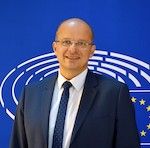
How can carbon-free hydrogen become more competitive?
Last December, 22 EU countries and Norway announced their willingness to engage into a new IPCEI (Important Project of Common European Interest) on hydrogen, highlighting the hopes that most of Europe has now placed in a technology that was until recently very much perceived as a niche. I strongly believe that hydrogen is indispensable for the EU to meet its environmental objectives, but also as a vector for job creation. The challenge is to make carbon-free hydrogen more competitive, so that it can be deployed as quickly as possible over Europe. This is one of my main objectives as Member of the European Parliament.
It is now widely accepted that we should reduce the share of hydrogen produced from natural gas, or “grey hydrogen”, which today remains the main means of producing hydrogen. However, the debate gets more complex when it comes to the role of “blue” hydrogen. Blue hydrogen refers to fossil-based hydrogen combined with carbon capture processes, which reduce overall life-cycle emissions of the energy carrier.
Blue hydrogen is expected to be a “bridge energy”, allowing for a transition to “carbon-free” hydrogen. The latter includes renewable (or “green”) hydrogen, which most often comes from electrolysis powered by renewable electricity.
Additionally, carbon-free hydrogen (or called by some “low-carbon hydrogen”) includes hydrogen produced via electrolysis from nuclear energy.
Despite the huge potential of carbon-free hydrogen, it has not yet been widely deployed in sectors which emissions are hard to abate and would greatly benefit from this solution. In fact, if we take the production of renewable hydrogen, it currently accounts for less than 1% of the annual hydrogen production in Europe. The reason is simple: it is simply not competitive yet. According to recent studies, whereas grey or blue hydrogen has a cost of €2-3 per kilo, the cost of renewable hydrogen varies between €5 and €6. There are indeed major barriers to the uptake of carbon-free hydrogen, especially due to an absence of appropriate regulatory framework.
I foresee several paths in order to address the lack of competitiveness of carbon-free hydrogen.
The production costs for carbon-free hydrogen is linked to the renewable electricity prices, the investment costs into electrolysers and the operating hours. These costs must be significantly reduced, through the scaling up of the production and the improvement of the technologies’ efficiency.
Electrolysers currently have an efficiency range of 60 to 80%.
Our research and innovation capacity will play a crucial part to improve these numbers. With the support of Member States, as well as the EU financial programmes such as Horizon Europe programme, I am confident that we will be able to mass-produce more efficient electrolysers in the coming years.
The cost of carbon-free hydrogen is also heavily reliant on the cost of electricity. The competitiveness of this electricity depends partly on the cost of CO2 under the EU ETS, as well as the dependence to national subsidies. Nuclear electricity, however, represents a more affordable option, as it can provide electricity at a competitive price to produce carbon-free hydrogen.
When considering the most cost-efficient ways to deploy hydrogen, an important element to consider is system flexibility. By focusing our attention on building new infrastructure or investing in new infrastructure, we tend to forget that the core principle of “energy efficiency first” ought to apply, not only to end uses, but to the entire energy value chain. By focusing on the existing energy infrastructure and making it more integrated and more coordinated, we can limit the need for new infrastructure. Innovative digital solutions can help us predict energy demand and manage energy supply, including the potential need for energy conversion, storage or balancing of the system. These ideas are enshrined in the concept of energy system integration, on which I am currently leading the work within the European Parliament as rapporteur on the Own-Initiative report exploring the matter.
While production costs and supply uptake are essential, the competitiveness of carbon-free hydrogen also lies in the creation of the right market conditions and incentives.
Several tried-and-tested instruments have the potential to create favourable market conditions for this uptake.
First, hydrogen being a new energy product for European consumers, I believe that there is a crucial need for transparency and information on its production and emissions. Guarantees of origin and certifications haven proved to be the best methods to inform customers, as well as to guarantee fair competition within the market.
Support schemes will also undeniably play a key role, if not the biggest role in the first years of commercialisation, to ensure that the price difference between fossil hydrogen and its greener alternatives is reasonable. Like for renewable electricity, CO2 pricing, taxes and levies weigh in heavily on final energy prices and customers’ decisions. Therefore, support schemes should go hand in hand with fiscal incentives for carbon-free hydrogen.
The EU is on the pathway to a real change of paradigm in its energy policy. From the presentation of the European hydrogen strategy, to the multiple national and even regional hydrogen strategies, all the options are on the table. Now is the time to find the right way to implement these strategies and make it a reality for all European citizens and businesses.




